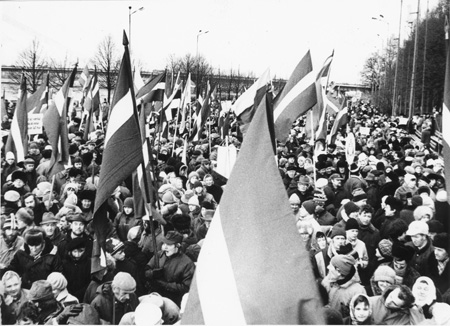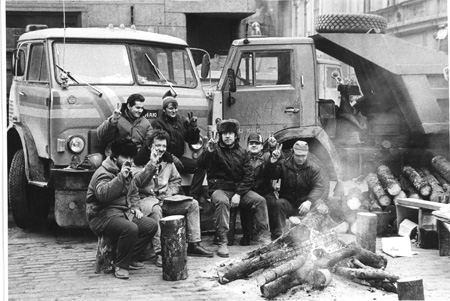Adoption of the Declaration of Independence, the Barricades (1990–1991)
Opponents of Latvia's independence became active after Latvia adopted the Declaration of Independence (4 May 1990). One such force was the USSR (Union of Soviet Socialist Republics) army units located in the territory of Latvia and their command, its officers and cadets. One of the first events directly involving soldiers that took place against the independence of Latvia was on 15 May, 1990, at the building of the former Republic of Latvia Supreme Council (now the House of Parliament [Saeima]). A great number of soviet army cadets and officers took part in this event, dressed in civilian clothes. The restless crowd was trying to break into the Supreme Council building during the Council's plenary meeting. This attempt was thwarted by the arrival of the Riga OMON (Otrjad miļiciji osobovo naznačenija - special militia task force), which drove the intruders away with clubs. But this time the OMON unit took the side of Latvia's statehood.
In autumn and winter of 1990, the activities of the soviet soldiers became more pronounced. Armed trucks and other military equipment drove through the central streets of Riga, army helicopters hovered above the city -soviet soldiers demonstrated their power and in several cases used it as well. For example, in Liepāja, the Soviet marines guarded the Vladimir Lenin monument located in the centre of Liepāja with the help of armoured personnel carriers, to prevent the implementation of the municipal decision to take down the monument.
On 14 November 1990, the Republic of Latvia Supreme Council adopted the decision to terminate the material supply of the USSR army located in Latvia.
On 15 May 1990, yet another political organisation was established that made the fight against the independence of Latvia its objective - the Committee for the protection of the constitutional and civil rights of the USSR and LSSR (Latvian Soviet Socialist Republic). The initiator of the Committee and the coordinator of its operation was the Central Committee of the Latvian Communist Party, led by Alfrēds Rubiks. At the end of 1990, this organisation was turned into the All-Latvian Public Rescue Committee. The activities of the Committee were closely linked to the USSR State Security Committee, the command of the Soviet Army Baltic military region and OMON force. The OMON force had refused to comply with the instructions of the Ministry of the Interior of the Republic of Latvia since September 1990, engaging in armed, systematic violent campaigns against Latvian independence and citizens. The All-Latvian Public Rescue Committee sent an invitation to Moscow to USSR president Mikhail Gorbachev to introduce direct presidential rule in Latvia.
In January 1991, the central power in Moscow began military character campaigns to restore its influence in the Baltic Republics. On the evening from 12 to 13 January, the Soviet army and specialised units attacked unarmed civilians at the television tower in Vilnius, Lithuania, killing 14 and injuring 110 civilians.

Around 500 000 people gathered on 13 January for the demonstration on the embankment of Daugava River, organised by the Latvian Popular Front in Riga to express support to Lithuanians and to demonstrate their readiness to continue the path to the restoration of the state independence. Barricades were put up during the day around the major state and public buildings and streets and access roads to strategic buildings were blocked by heavy-duty equipment. The non-violent civilians stood on the barricades, proving to the world their readiness to sacrifice their lives to defend Latvian independence.
Since most of the significant buildings were located in Old Town Riga, its territory became the central gathering place of the defenders of the barricades. The narrow streets were blocked by heavy machinery and concrete blocks, leaving only narrow paths to travel through. There are stories about Baltic Military District Commander General Fyodor Kuzmin's reply to the question of why he did not give orders to the army to take control over Old Town. He is said to have evaluated the strength of those defending the barricades as being equal to three infantry divisions and had forecasted mass casualties if conflicts were to arise between the army and the defenders of the barricades. Advocates of the Soviet power could no longer afford such results because events in Vilnius and Riga had sparked wide interest in the Western countries.

January 1991 Event Timeline
1 January - The Riga OMON force takes over the Latvian Press Building under order of the Latvian Communist Party Central Committee.
4 January - The delegation of USSR Ministry of the Interior representatives arrives in Riga, led by Lieutenant General Solodkov. The purpose of the delegation is to prevent anti-Soviet activities in Latvia.
7 January - USSR Minister of Defence Dmitriy Yazov gives the order to deploy paratroops to Latvia, Lithuania and Estonia to ensure the annual draft to the USSR military service.
8 January -The Republic of Latvia Supreme Council adopts the decision On Illegal Entry of the USSR Armed Forces into Latvia.
9 January - The US Government releases a statement denouncing the arrival of additional USSR military forces in the Baltic States.
10 January - USSR President Mikhail Gorbachev sends an invitation to the Republic of Lithuania Parliament to cancel all newly adopted constitutional regulations.
An unauthorised Interfront rally takes place in Riga, demanding the resignation of the government led by Ivars Godmanis. Around 10 000 people attend the rally, after which an attempt is made to break into the Council of Ministers building.
11 January - The Latvian Women's League stages a protest at the Esplanāde Square in Riga against the draft of Latvian youths to the Russian occupation army. Around 6 000 people participate in the protest campaign.
12 January - The Latvian Popular Front announces a national demonstration for the following day to support the lawfully elected government.
The Presidium of the Supreme Council of the Russian Soviet Federative Socialist Republic calls on the USSR Government to withdraw additional military forces from the Baltic Republics.
Chairman of the Republic of Latvia Supreme Council Anatolijs Gorbunovs and Chairman of the Council of Ministers Ivars Godmanis meet with USSR President Mikhail Gorbachev in Moscow. President Gorbachev promises not to use military force in Riga.
13 January - Soviet tanks surround the Republic of Lithuania Supreme Council building in Vilnius and take over the Lithuanian television, radio and telegraph facilities. 14 people are killed and another 110 are injured.
At 04:45 - In a radio address, Dainis Īvāns invites people to gather at Dom Square in Riga and announces the events in Lithuania.
At 14:00 - A national demonstration takes place on the 11 November Embankment in Riga, gathering around 500 000 participants. After the rally, barricades are erected in Old Town, at Zaķusala and at major strategic objects in Riga. The Defence Headquarters staff is formed (Head - Andrejs Krastiņš, Deputies - Odisejs Kostanda and Tālis Jundzis).
Chairman of the Supreme Council of the Russian Soviet Federative Socialist Republic Boris Yeltsin signs an appeal to the army soldiers called into military service from the territory of the Russian Federation to refrain from participating in campaigns against civilians.
Anatolijs Gorbunovs and Boris Yeltsin sign a contract in Tallinn on the international relations between Latvia and the Russian Federation.
14 January - Commander of the Soviet army in the Baltic Military District Fyodor Kuzmin issues an ultimatum against Chairman of the Republic of Latvia Supreme Council Anatolijs Gorbunovs, demanding the adopted laws be repealed.
USSR President Mikhail Gorbachev and Minister of the Interior Boris Pugo emphasise in a special statement that the Soviet army acted accordingly in Lithuania. The actions of the army in Vilnius are denounced by NATO leadership.
In the late hours before 15 January, OMON forces attack the Riga Police School in Āgenskalns.
15 January - During an Interfront rally in Riga, the so-called All-Latvian Rescue Committee adopts a resolution on the takeover of power by the Committee.
16 January - Roberts Mūrnieks is shot at 16:45 in Vecmīlgrāvis at the Mangaļi bridge.
At 20:45 - A bomb explodes at the building of Political Education in Riga. There are no victims or damage.
17 January - The US army launches the liberation of Kuwait, thus initiating operation Desert Storm.
18 January - Overnight, OMON forces detain and beat up five policemen.
20 January - Overnight, OMON forces break into the Ministry of the Interior building. Vladimir Gomanovich, Sergeiy Kononyenko, Andris Slapiņš and Edijs Riekstiņš are killed; Gvido Zvaigzne is fatally wounded (died 5 February.)
21 January - Anatolijs Gorbunovs leaves for Moscow to discuss the events in Latvia with Mikhail Gorbachev.
22 January - Boris Pugo denies giving the orders to attack the Ministry of the Interior.
25 January - National Day of Mourning, the funerals of the victims of 20 January are held.
The defenders of the Barricades leave.